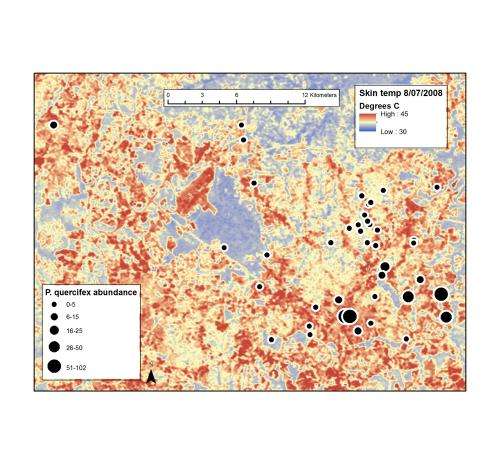Insect pests more plentiful in hotter parts of city than in cooler areas

Higher temperatures in cities can be a key driver of insect pest outbreaks on trees in urban areas, according to research published March 27 in the open access journal PLOS ONE by Emily Meineke from North Carolina State University and colleagues from other institutions.
The researchers found that a scale insect that exclusively feeds on oak trees was 13 times more abundant on willow oaks in the hottest parts of the city of Raleigh, North Carolina than in cooler areas of the same city, even when other factors, like natural enemies that would kill the insects, were similar in both areas. In a second experiment, they found scale insects collected from trees in hot areas had higher survival rates in hot greenhouses than in cool ones. However, insects originally from cooler urban areas remained low in number in both hot and cool greenhouses. The researchers found no differences in the rates of reproduction of insects in any of these groups. Thus, they suggest that the differences in abundance may be a result of differences in survival rather than a higher reproductive capacity.
Urbanization of an area changes the species that dwell in it. Previous studies have analyzed these effects in terms of loss of resources or changes to habitat, but this is the first research to focus on the effects of "heat islands" created in cities. Meineke explains that, "Urban warming can lead to higher insect pest abundance, a result of pest acclimation or adaptation to higher temperatures."
The study concludes that since current urban warming is similar in magnitude to the higher temperatures predicted by global warming in the next fifty years, their results may indicate potential changes in pest abundance as natural forests also grow warmer.
More information: Meineke EK, Dunn RR, Sexton JO, Frank SD (2013) Urban Warming Drives Insect Pest Abundance on Street Trees. PLoS ONE 8(3): e59687. doi:10.1371/journal.pone.0059687
Journal information: PLoS ONE
Provided by Public Library of Science















